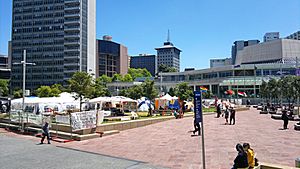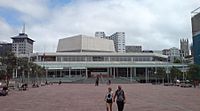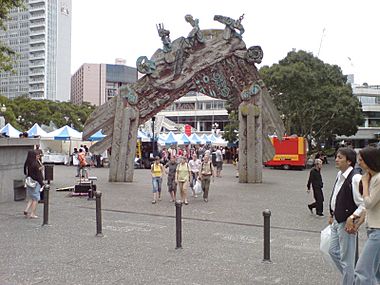Aotea Square facts for kids
Aotea Square is a large public space in the heart of Auckland, New Zealand. It was officially opened in 1979. The square is a popular spot for many events. These include outdoor concerts, big gatherings, markets, and even political rallies.
In November 2010, Aotea Square got a big makeover. It was redesigned to be perfect for crowds of up to 20,000 people. The name Aotea comes from Motu Aotea. This is the Māori name for Great Barrier Island. This island is the largest offshore island of New Zealand. It is about 90 km from downtown Auckland.
Contents
History of Aotea Square
How the Square Was Built
Aotea Square was created in 1979. A big part of it used to be the end of Grey's Avenue. This street once connected directly to Queen Street. A large underground car park was built beneath the square in 1975. It has 930 parking spots.
In 2000, a competition was held to redesign the square. But in 2004, problems were found with the car park roof. This stopped the redesign project. The roof was fixed temporarily. Later, a new plan was made and revised several times. The big upgrade project started in November 2008. It finished in late 2010. During this time, no events could be held in the square. The project cost about NZ$80 million. This included fixing the car park and upgrading the square.
Important Events in the Square

Aotea Square is often used for public events. These include fun fairs, protest rallies, and music festivals.
On December 7, 1984, a free rock concert was held here. Bands like Herbs and DD Smash played. It was a very big gathering that got a bit out of hand.
Starting on October 15, 2011, the square was the site of an Occupy Movement protest. People set up tents and shelters. They camped in the grassy areas. The protest ended by late January 2012.
Buildings Around Aotea Square
The old Auckland Town Hall is at the Queen Street entrance. It has a main concert hall with great sound. It was fully restored in 1994.
To the south of the square, you'll find the Auckland City Council building. There is also an entrance to Myers Park.
On the western side of the square is the Aotea Centre. This is Auckland's main place for conferences and theatre shows. Inside its lobby, you can see artworks by many New Zealand artists. This includes a bronze statue of Dame Kiri Te Kanawa.
To the north of the square is a cinema and theatre complex. This includes the Event Cinema and the old Civic Theatre. The Civic Theatre was built in 1929. Its main room has lights that look like the stars in the southern night sky.
Aotea Square was once a swampy area. It was drained by the Waihorotiu Stream. The stream was later covered over. A three-story underground parking garage was built in the 1970s. You can access it from Mayoral Drive and Greys Avenue.
Public Art in the Square
Aotea Square has several interesting art pieces:
- At the Queen Street entrance, there is an arch called 'Waharoa'. This means Gateway in Māori. It was made from wood and copper by Selwyn Muru, a Māori sculptor. It looks like a traditional Māori entry gate. It has symbols like birds, fish, and the crescent moon and stars. It also includes modern symbols, like the nuclear disarmament sign.
- In front of the Town Hall, there is a bronze statue of Sir Dove-Myer Robinson. He was a former mayor of Auckland. This statue was made in 2003 by New Zealand sculptor Toby Twiss.
- Near the Town Hall, there is a bronze figure of a Māori warrior. It was made by Lyndon Smith. This statue was given to the City of Auckland in 1997.
- In the center of the square, there used to be a bronze fountain. It was made by New Zealand sculptor Terry Stringer. This fountain was moved to the Holy Trinity Cathedral in Parnell.
- In front of the Administration building, there is a 19th-century bronze statue of George Eden, Lord Auckland. The city of Auckland is named after him. This statue was originally in Calcutta, India. Auckland City Council bought it in the 1960s.
- In April 2011, a large temporary sculpture was placed in the square. It was by Japanese artist Ujino. It was called Dragonhead.
See also
 In Spanish: Plaza Aotea para niños
In Spanish: Plaza Aotea para niños






